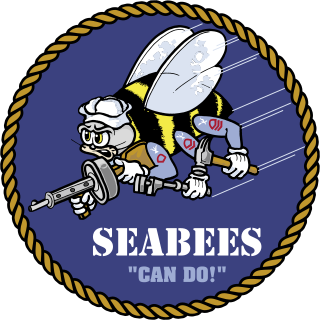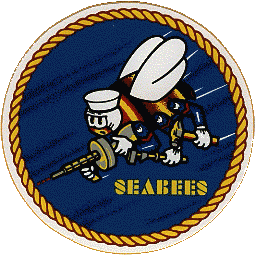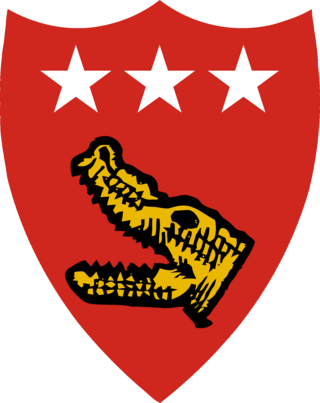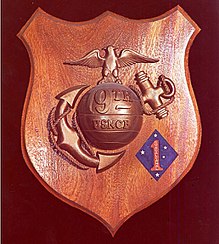
The Battle of Peleliu, codenamed Operation Stalemate II by the US military, was fought between the United States and Japan during the Mariana and Palau Islands campaign of World War II, from September 15 to November 27, 1944, on the island of Peleliu.

United States Naval Construction Battalions, better known as the Navy Seabees, form the U.S. Naval Construction Force (NCF). The Seabee nickname is a heterograph of the initial letters "CB" from the words "Construction Battalion". Depending upon context, "Seabee" can refer to all enlisted personnel in the USN's occupational field 7 (OF-7), all personnel in the Naval Construction Force (NCF), or Construction Battalion. Seabees serve both in and outside the NCF. During World War II they were plank-holders of both the Naval Combat Demolition Units and the Underwater Demolition Teams (UDTs). The men in the NCF considered these units to be "Seabee". In addition, Seabees served as elements of Cubs, Lions, Acorns and the United States Marine Corps. They also provided the manpower for the top secret CWS Flame Tank Group. Today the Seabees have many special task assignments starting with Camp David and the Naval Support Unit at the Department of State. Seabees serve under both Commanders of the Naval Surface Forces Atlantic/Pacific fleets as well as on many base Public Works and USN diving commands.

The 1st Marine Division is a Marine division of the United States Marine Corps headquartered at Marine Corps Base Camp Pendleton, California. It is the ground combat element of the I Marine Expeditionary Force.

The 5th Marine Division was a United States Marine Corps ground combat division which was activated on 11 November 1943 at Camp Pendleton, California during World War II. The 5th Division saw its first combat action during the Battle of Iwo Jima in 1945 where it sustained the highest number of casualties of the three Marine divisions of the V Amphibious Corps. The 5th Division was to be part of the planned invasion of the Japan homeland before Japan surrendered. Assault troops of the 5th Division were included in the Presidential Unit Citation awarded to the V Amphibious Corps for extraordinary heroism on Iwo Jima from 19 to 28 February 1945. The 5th Division was deactivated on 5 February 1946.

The 7th Marine Regiment is an infantry regiment of the United States Marine Corps based at Marine Corps Air Ground Combat Center Twentynine Palms, California. Nicknamed the "Magnificent Seventh", the regiment falls under the command of the 1st Marine Division and the I Marine Expeditionary Force.

The 23rd Marine Regiment is a reserve infantry regiment of the United States Marine Corps. It is headquartered in San Bruno, California and falls under the command of the 4th Marine Division and the Marine Forces Reserve.

The Civil Engineer Corps (CEC) is a staff corps of the United States Navy. CEC officers are professional engineers and architects, acquisitions specialists, and Seabee Combat Warfare Officers who qualify within Seabee units. They are responsible for executing and managing the planning, design, acquisition, construction, operation, and maintenance of the Navy's shore facilities. The Civil Engineer Corps is under the command of the Chief of Civil Engineers and Commander, Naval Facilities Engineering Systems Command. On 12 August 2022, RADM Dean VanderLey relieved RADM John W. Korka, becoming the 46th commander of NAVFAC and Chief of Civil Engineers.

The 26th Marine Regiment is an inactivated infantry regiment of the United States Marine Corps. The 26th Marines were activated in 1944 and fought in the Battle of Iwo Jima during World War II and were activated again on 1 March 1966, and fought in the Battle of Khe Sanh during the Vietnam War.

When World War II broke out the United States Naval Construction Battalions (Seabees) did not exist. The logistics of a two theater war were daunting to conceive. Rear Admiral Moreell completely understood the issues. What needed to be done was build staging bases to take the war to the enemy, across both oceans, and create the construction force to do the work. Naval Construction Battalions were first conceived at Bureau of Yards and Docks (BuDocks) in the 1930s. The onset of hostilities clarified to Radm. Moreell the need for developing advance bases to project American power. The solution: tap the vast pool of skilled labor in the U.S. Put it in uniform to build anything, anywhere under any conditions and get the Marine Corps to train it. The first volunteers came skilled. To obtain these tradesmen, military age was waived to age 50. It was later found that several past 60 had managed to get in. Men were given advanced rank/pay based upon experience making the Seabees the highest paid group in the U.S. military. The first 60 battalions had an average age of 37.

The V Amphibious Corps (VAC) was a formation of the United States Marine Corps which was composed of the 3rd, 4th and 5th Marine Divisions in World War II. The three divisions were the amphibious landing force for the United States Fifth Fleet with two goals, removal of Japanese forces from islands so U.S. Seabees could build advance bases to project US power. In doing this VAC was notably involved in the battles for Tarawa, Saipan, and Iwo Jima. V Amphibious Corps was commanded by General Holland 'Howlin Mad' Smith followed by General Harry Schmidt.

The 22nd Marine Regiment is an inactive United States Marine Corps infantry regiment. The regiment was commissioned in 1942 and was placed under the command of the 1st Provisional Marine Brigade in 1944, and the 6th Marine Division in 1945. It took part in fighting at the battles of Eniwetok, Guam, and Okinawa. The regiment also participated in the occupation of northern China following the war. 22d Marines was decommissioned in March 1946.

20th Marine Regiment was a Composite Engineer Regiment of the United States Marine Corps that fought during World War II.

The 19th Marine Regiment was a composite engineer regiment of the United States Marine Corps subordinate to the 3rd Marine Division. It existed from September 1942 until September 1944. In December 1943 there was a large change of command in the Regiment. Marine engineer regiments were eventually disbanded in favor of independent engineering battalions within the parent Marine divisions.

The 18th Marine Regiment was a composite engineer regiment of the United States Marine Corps subordinate to the 2nd Marine Division. It was disbanded during the war, with the 1st and 2nd battalions remaining in the Division.
The 16th Marine Regiment was a composite engineer regiment of the United States Marine Corps subordinate to the 5th Marine Division. While its subordinate battalions went to the Pacific Theater as part of the 5th Marine Division, the Regimental headquarters was disbanded while still in the United States.

Naval Mobile Construction Battalion 133 is a United States Navy Construction Battalion, otherwise known as a Seabee Battalion, homeported at the Naval Construction Battalion Center. The unit was formed during WWII as the 133rd Naval Construction Battalion. It saw action and was decommissioned shortly after the war ended. The unit was reactivated as Mobile Construction Battalion 133 for the Vietnam War and remains an active unit today.

Naval Mobile Construction Battalion 25 or NMCB 25 is a Navy Reserve Seabee unit that is headquartered at Port Hueneme, CA. Its World War II predecessor was one of three CBs transferred to the Marine Corps in the late summer of 1942 as combat engineers. Those three battalions were attached to composite Marine Engineer Regiments as the third battalion of their respective regiment. All of them remained with the Marine Corps for the next two years before they were released and returned to the Navy. At the end of World War II the battalion was decommissioned. In 1961, it was recommissioned in the Naval Construction Force Reserve where it remains today.

Naval Construction Battalion 5 was commissioned on May 25, 1942 at Camp Allen Va. The battalion went to Port Hueneme and shipped out for the first of two deployments in the Pacific. When the war ended CB 5 was decommissioned in the Philippines. On July 10, 1951 the Battalion was re-commissioned as a MCB and remains an active unit today.

On 21 July 1944, United States Marine and Army forces invaded the island of Guam, the southernmost of the Mariana Islands chain in the Central Pacific, with the intent to take control of the island from the Imperial Japanese Army. Operation Forager II, as it was called by American planners, was a phase of the Pacific Theatre of World War II.

When WWII broke the United States had no mechanized flamethrowing capability. It is believed that an officer in the 754th U.S. Army tank battalion came up with the idea of mounting a flame thrower on a M3 Light tank on the island of New Caledonia. The Army used the idea on New Georgia and the Marines during the Battle of Bougainville. After which further development passed to the U.S. Army. Chemical Warfare Service at Schofield Barracks, Territory of Hawaii. There the Army reached out to the United States Naval Construction Force for assistance. The Seabees accepted the offer and converted or modified nearly 400 tanks for the Army. Those weapons set the standard for the U.S. through the Korean War. It was not until 1955 that a superior flame throwing tank replaced the Shermans the Seabees created.























